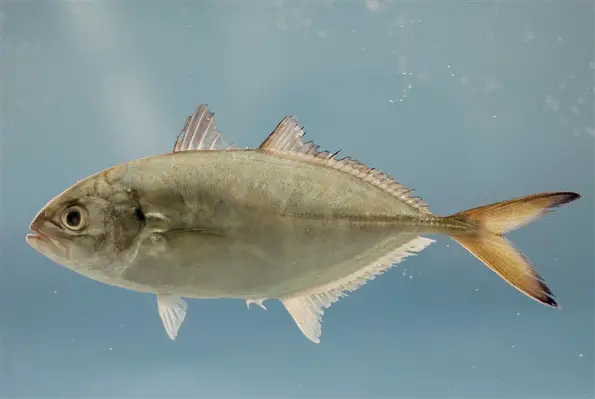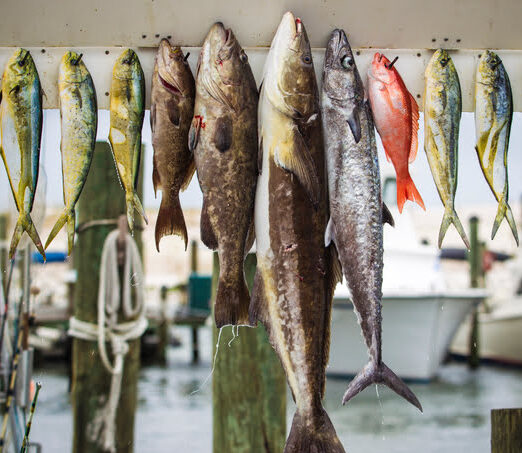Blue Runners are large and fast fish belonging to the Jack family, sometimes referred to as the Blue Stripe Jack, Hardtail Jack, or Egyptian Scad (Caranx crysos). They are ferocious predators, a great challenge to catch and make even better for eating.
Even though they are a joy to catch, are blue runners good to eat?
Table of Contents
- Can You Eat Blue Runners?
- What do Blue Runners Taste Like?
- What Do I Need To Know About Filleting Blue Runners?
- How do I Fillet a Blue Runner?
- Blue Runner Poke Recipe
- How Do I Identify a Blue Runner?
- Where Can I Find Blue Runners?
- Are Blue Runners Good Bait Fish?
- Frequently Asked Questions
- What Is The Harvester Limit For Blue Runners In Florida?
- What Are The Main Things You Can Do With Blue Runners?
- Are Blue Runners Healthy?
- Are Blue Runners a Sustainable Option?
- How Fast are Blue Runners?
- Are Blue Runners High in Mercury?
- Are Blue Runners Kosher?
- Are Blue Runner and Bluefish the Same?
- How Expensive is Blue Runner?
- Conclusion
Can You Eat Blue Runners?
Yes, while most people revere them as great baitfish, they are also a good option for a cheap and healthy meal!

Blue runners can grow up to 11 lbs or 5 kg and up to 27 inches or 70 cm, and they taste great raw, making them a good alternative to tuna or other more expensive fish.
What do Blue Runners Taste Like?
When cooked, blue runners tend to taste a bit bland, however with a bit of seasoning, they can provide a nice flaky base for great table fare.
Many fishers also insist their meat tastes much better raw, making them a great candidate for dishes like sashimi, poke, or sushi.
What Do I Need To Know About Filleting Blue Runners?
Many people tend to only use blue runners as bait due to their low meat-to-size yield and their large blood-line. However, if you’re willing to take a few extra minutes to ensure you take out that blood-line, you’ll have a perfect fish for a quick meal.
Ensure you don’t cut into their stomach or gallbladder while filleting as if they are cut into, they can cause the fish to taste bitter.
Their tails are also quite fleshy, and they almost feel like bone when you’re cutting through them.
If your knife is too blunt, or you are not careful with it, you could end up with one less finger than you started. So, make sure you’re careful when filleting.
If you are interested in more specifics on the physiology of blue runners in relation to filleting, you should check out the biography from the Smithsonian Tropical Research Institute.
How do I Fillet a Blue Runner?
After bleeding out your catch, start cutting from behind the pectoral fin with a sharp knife. Turn the knife around as you go down along their spine all the way to their tail.
Their tail skin is quite tough so try to cut right through to the end. Move your knife along their spine and ribs to create two fillets. This would also be a great time to cut out their stomach before you start skinning.
You will notice these fish have quite a bit of the blood-line closer to the skin. When you remove the skin from the fish, carefully work from tail to head with your sharp knife.
You don’t want to eat the meat near the dark blood-line as it’s quite fishy, so make sure to remove that as well prior to cooking.
Blue Runner Poke Recipe
This is a simple recipe that requires no cooking as the fish is eaten raw. Most people agree their meat is best raw, just be sure to only use the freshest fish to make this delicious and easy meal.

Ingredients
- 3-4 fillets of Blue Runner
- 3-4 scallions
- ½ cup of ponzu sauce
- ½ cup of soy sauce
- 1 tbsp of rice vinegar
- 1 tsp of sesame oil
- ½ cup of rice
- 1 Avocado
- 1 Carrot
- 1 Pepper
- 1 Mango
- Drizzle of sriracha
Instructions
- First, start by cooking ½ cup of rice either in a rice cooker or on the stove.
- Next, cut your fillets into ¾ inch cubes and place them in a bowl.
- Chop up 1-2 scallions and add to the fillets.
- Mix ½ cup ponzu and soy sauce, 1 tbsp rice vinegar, and 1 tsp of sesame oil into the bowl to make a marinating sauce.
- Sprinkle some sesame seeds and stir the fish with the sauces.
- Let the bowl of fish and sauces chill in the refrigerator for around 30 minutes.
- Place the cooked rice in a new bowl and add the fish and sauce on top.
- Add ½ an avocado, some grated carrots, a few peppers and scallions fresh on top.
- Chop some mango and add as a garnish on top.
- Cover in sriracha as needed.

Do You Love Seafood?
How Do I Identify a Blue Runner?
Blue runners are quite shiny and beautiful!
Their silvery grey skin is complimented by their golden bellies and dramatically forked tails. Their distinguishing feature is a black spot that can be found on their gill cover.
Inshore runners often have a blue or green tint to them, whereas larger, offshore specimens have darker skin.
As another helpful tip, the darker the fish, the more likely it will have better meat for eating.
Where Can I Find Blue Runners?
Blue Runners are often found both inshore and offshore, near artificial reefs and even in lagoons up and down the eastern and western Atlantic ocean coast.
Oceanic runners tend to be larger than the ones closer to shore, so if you’re hoping for a larger meal, head out a bit further into the sea!
Blue runners are best caught between June and August during their spawning season, but can be caught year-round.
Are Blue Runners Good Bait Fish?
There seems to be a misconception that these fish are only good bait for larger fish like Kingfish, however, that is not true. They can be used for bait in most offshore fishing applications.
Frequently Asked Questions
What Is The Harvester Limit For Blue Runners In Florida?
Currently, there is a 100 fish per harvester limit in the state of Florida.
What Are The Main Things You Can Do With Blue Runners?
You can either catch and cook them up, or use them as bait to catch Cubera Snapper or Almaco Jacks.
Are Blue Runners Healthy?
Like most fish, they are an excellent source of omega-3 fatty acids and protein and have relatively few calories per serving. This makes them incredibly healthy for as far as meat goes!
Are Blue Runners a Sustainable Option?
Due to their biology, since they grow and mature quickly, Blue Runners are a sustainable option as they often have time to reproduce prior to being caught.
How Fast are Blue Runners?
Blue Runners are extremely fast fish, which can make them difficult to catch. Their speed is mostly attributed to their status of being fearsome predators.
Are Blue Runners High in Mercury?
Larger fish tend to have lived longer and eaten much more prey, allowing them to accumulate higher levels of mercury over their lifetime. However, unless you’re eating them multiple times a week, this shouldn’t be an issue.
Are Blue Runners Kosher?
Yes, Blue Runners are suitable for those following the Kosher diet.
Are Blue Runner and Bluefish the Same?
Blue Runners and Bluefish are completely different species that are members of entirely different families. Bluefish are usually paler in color than Blue Runners.
Blue Runners also have a much longer pectoral fin. Blue Runners inhabit reef habitats whereas Bluefish are more often found in open ocean waters as they are migratory fish.
How Expensive is Blue Runner?
Blue Runners are an incredibly affordable fish due to their abundance and relative availability to commercial and recreational fishermen alike.
Conclusion
Blue Runners are an affordable, abundant and delicious option that you can almost always find in your local supermarket. They’re great for eating or to use as bait!

Growing up in Florida, I’ve been surrounded by saltwater my entire life…and I love sharing my passion with others.
To learn more about why I started Saltwater Mecca, visit the ABOUT page.
Thank you for reading this article. Browse around & have some fun!